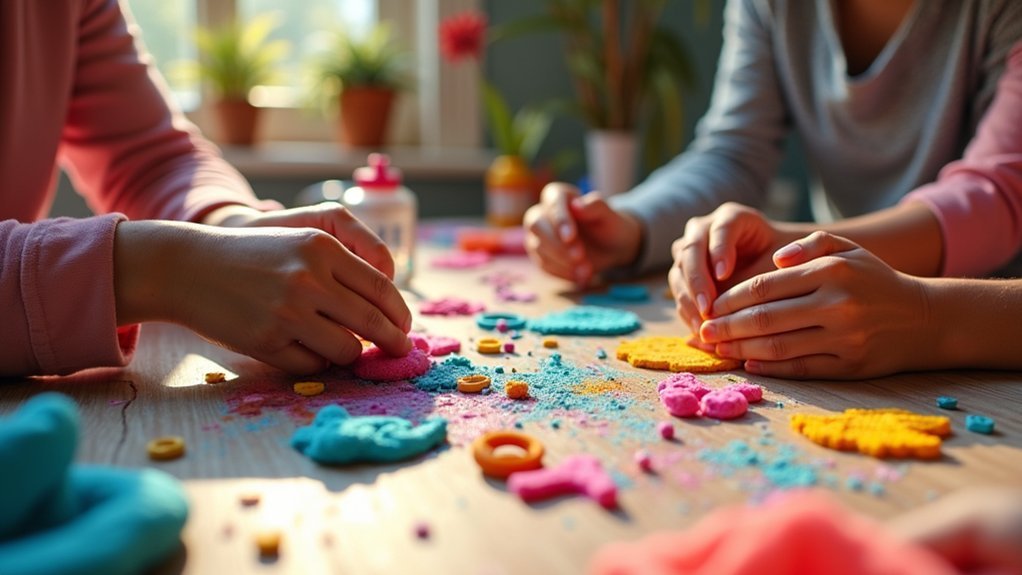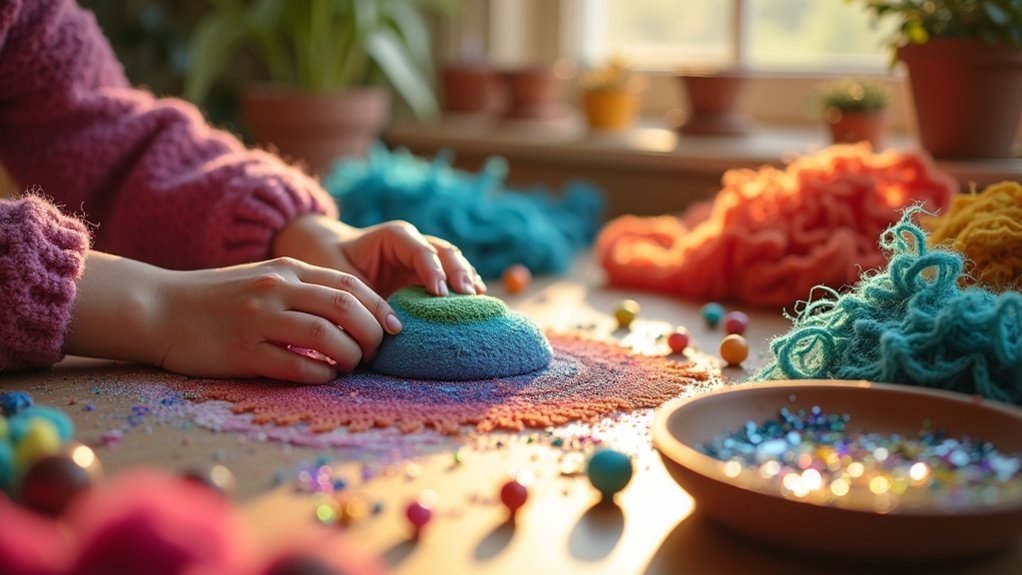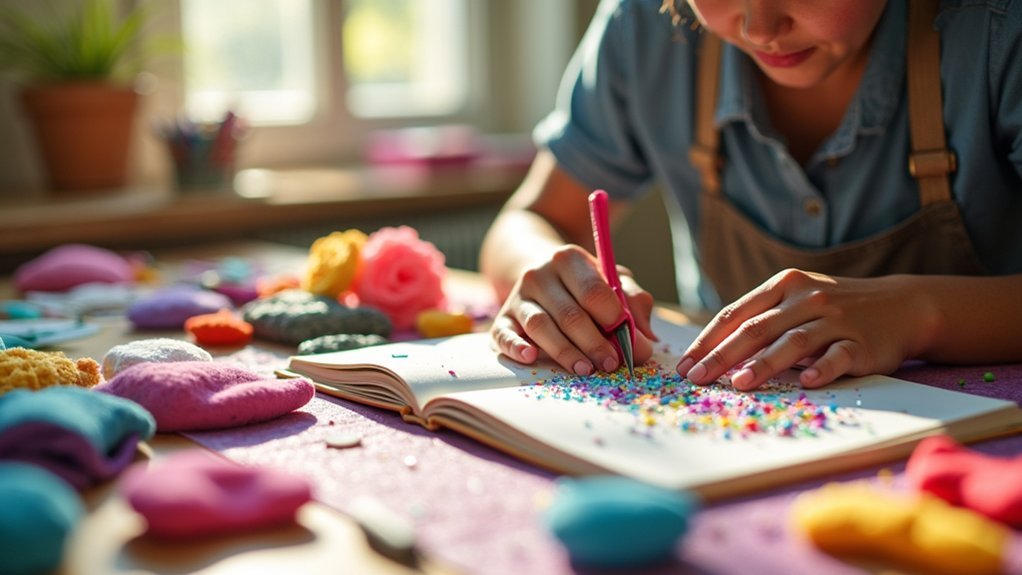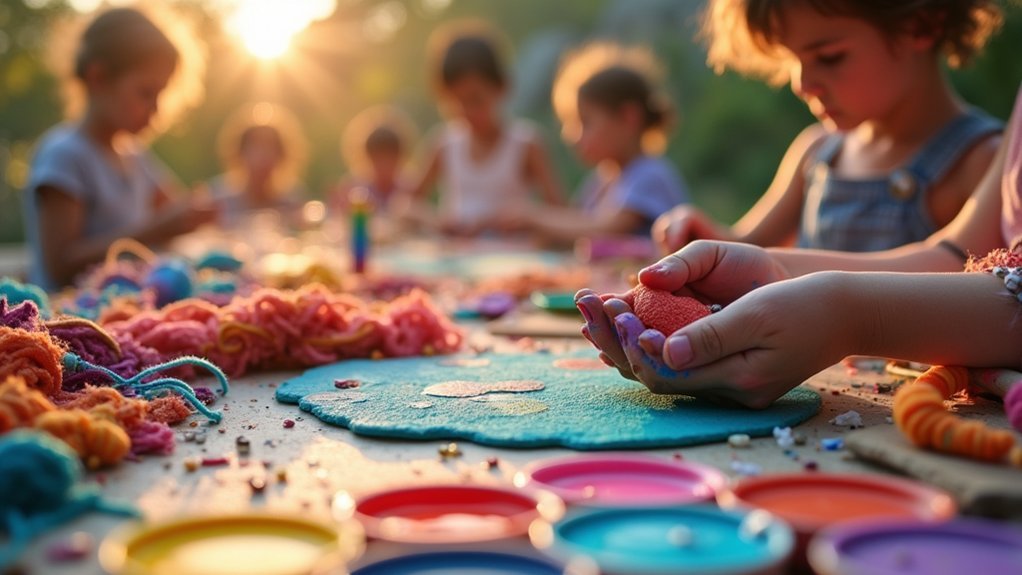Sensory crafts offer neurodivergent adults powerful anxiety reduction through multi-sensory engagement. You’ll strengthen fine motor skills while expressing emotions through texture, color, and scent. Try fabric collages, clay sculpting, or custom aromatherapy projects that match your unique sensory preferences. Adaptive tools like ergonomic scissors and weighted brushes make creating more accessible. Set up a sensory-friendly craft space with adjustable lighting and sound management for maximum comfort. These hands-on activities reveal pathways to joy beyond traditional therapeutic approaches.
Sensory Crafts for Neurodivergent Adults: Hands-On Joy

While many traditional hobbies focus primarily on the end result, sensory crafts offer neurodivergent adults a uniquely rewarding journey through texture, color, and form. As you explore different materials—from soft clay to smooth beads or rough textiles—you’re engaging multiple sensory experiences that can be both calming and stimulating.
These hands-on activities strengthen fine motor skills while providing meaningful outlets for emotional expression. Whether you’re kneading clay to release tension or selecting colors that reflect your mood, you’re developing important self-regulation techniques. The process itself becomes therapeutic, with studies confirming that crafting reduces anxiety and stress.
What makes sensory crafts particularly valuable is their adaptability—you can incorporate scents, sounds, and textures that match your personal preferences, creating a completely customized creative experience.
The Science Behind Sensory Crafting for Neurodivergent Minds
When neurodivergent adults engage in sensory crafting, they’re activating complex neurological pathways that benefit their unique brain structures in remarkable ways.
Research shows that 63% of participants experience reduced anxiety through regular sensory input during crafting activities.
Your brain forms new neural connections through hands-on creation, enhancing:
- Emotional regulation through multi-sensory exploration
- Fine motor skills and coordination through tactile engagement
- Cognitive skills via active sensory processing
- Social development when participating in group crafting sessions
You’re not just making something beautiful—you’re actively rewiring your brain.
The tactile nature of sensory crafts improves dexterity while simultaneously providing calming input that helps manage overstimulation, making crafting both therapeutically valuable and enjoyable for neurodivergent minds.
Tactile Treasures: Texture-Based Projects for Sensory Exploration

Diving into texture-based crafts opens a world of sensory delight for neurodivergent adults seeking tactile stimulation.
You’ll find fabric collages with buttons particularly engaging—these projects encourage your hands to explore varied textures while developing sensory processing skills.
Clay sculpting offers another dimension of tactile experiences, allowing you to mold and shape materials while expressing yourself creatively.
Don’t overlook nature crafts; leaf rubbings and pinecone bird feeders connect you with organic textures during outdoor exploration.
For calming sensory exploration, try creating personalized sensory bins filled with rice, sand, or beads.
These tactile experiences can reduce anxiety through focused touch interaction.
Texture-based projects incorporating diverse materials like yarn stimulate both creativity and cognitive development, making them valuable additions to your sensory toolkit.
Aromatherapy Craft Kits: Engaging Multiple Senses
The fusion of scent and touch elevates aromatherapy craft kits to powerful sensory tools for neurodivergent adults.
For neurodivergent adults, aromatherapy crafting becomes a sensory sanctuary where scent and touch intertwine to create powerful regulatory experiences.
When you create your own scented candles or bath salts, you’re not just crafting—you’re engaging in a complete sensory experience that promotes relaxation and emotional regulation.
Research shows that certain scents directly impact anxiety levels, making aromatherapy particularly beneficial for self-regulation.
You’ll find the process naturally encourages mindfulness as you:
- Select fragrances that personally resonate with your sensory preferences
- Explore various textures of ingredients like salts, waxes, and dried flowers
- Customize products to your exact sensory needs
- Focus on present-moment awareness while blending and creating
Adaptive Tools That Make Crafting Accessible for Everyone

Crafting becomes truly inclusive once you’ve discovered the right adaptive tools for your specific needs. These specialized implements enhance your crafting experience by accommodating various dexterity levels and sensory preferences.
| Adaptive Tool | Sensory Engagement Benefit |
|---|---|
| Ergonomic scissors | Reduces hand fatigue during cutting tasks |
| Easy-grip paintbrushes | Improves control for detailed work |
| Textured materials | Provides tactile stimulation and comfort |
| Weighted tools | Increases proprioceptive feedback |
| Compression gloves | Stabilizes joints while crafting |
Visual aids like color-coded materials and step-by-step instructions support your creative process while maintaining independence. Don’t forget to incorporate fidget tools nearby for moments when you need additional sensory regulation. With non-toxic, hypoallergenic supplies, you’ll create a crafting environment that’s both safe and stimulating.
Low-Stimulation Crafts for Overwhelm Prevention
When overwhelm threatens to cloud your creative space, low-stimulation crafts offer a gentle refuge for your sensory system.
These activities provide predictable, repetitive motions that can greatly reduce anxiety while allowing your creativity to flow without pressure.
The sensory experience of simple crafting creates a calming effect on your nervous system.
Research confirms these activities lower anxiety levels through their therapeutic rhythms and tactile engagement.
Try these low-stimulation crafts when you need to reset:
- Basic knitting with soft, comfortable yarn
- Watercolor painting with limited color palettes
- Simple coloring with minimal pattern complexity
- Clay work focusing on the tactile sensation
Incorporating mindfulness into your crafting enhances the calming benefits—notice the weight of materials in your hands and the rhythm of your movements as you create.
Weighted and Pressure-Based Craft Activities for Regulation
Creating your own DIY weighted blanket combines the therapeutic benefits of deep pressure input with the satisfaction of completing a personalized craft project.
You’ll find that working with weighted beads in crafting projects can provide immediate calming effects while keeping your hands productively engaged during anxious moments.
These pressure-based activities offer both the regulatory benefits supported by research—showing up to 63% reduced anxiety levels—and the creative outlet that makes crafting so valuable for neurodivergent adults seeking sensory regulation.
DIY Weighted Blankets
Deeply therapeutic and fully customizable, weighted blankets have become a cornerstone tool for many neurodivergent adults seeking sensory regulation.
You can create your own DIY weighted blanket that perfectly matches your sensory preferences while enjoying the crafting process itself. Research shows these blankets reduce anxiety levels in 63% of users, making them particularly beneficial for autistic individuals.
When making your weighted blanket, consider these key elements:
- Weight distribution – Create evenly filled pockets using glass beads or rice
- Fabric selection – Choose textures that feel comforting against your skin
- Customization options – Add various colors and patterns that appeal to you
- Personal touches – Incorporate special fabrics with meaningful connections
The hands-on nature of this project doubles as both a calming activity and a path to creating a personalized tool for future self-regulation.
Calming Bead Projects
Beyond weighted blankets, smaller weighted items can offer powerful sensory regulation benefits throughout your day. Creating weighted bead jewelry provides customizable deep pressure input, potentially improving focus by 18-25%. The tactile experience of stringing beads offers a rhythmic, calming activity that enhances self-regulation.
| Project Type | Sensory Benefit | Materials to Try |
|---|---|---|
| Weighted Necklace | Deep pressure around neck | Glass or stone beads |
| Stretch Bracelet | Portable calming tool | Textured silicone beads |
| Fidget Keychain | On-the-go regulation | Wooden or metal beads |
| Anklet | Grounding sensation | Varying weight beads |
| Sensory Garland | Visual and tactile stimulation | Mixed material beads |
You’ll benefit most when selecting beads that match your specific sensory preferences—experiment with different textures, weights, and materials to discover what provides the most effective calming experience.
Customizing Craft Spaces for Sensory Comfort
When designing a craft space that truly supports neurodivergent needs, the environment itself becomes as important as the activities it hosts.
Create a sanctuary that addresses unique sensory needs through thoughtful organization and materials selection. Incorporate tactile materials throughout your space, allowing for exploration based on individual preferences.
You’ll find adjustable seating options essential for maintaining comfort during longer crafting sessions.
Transform your space with these essential elements:
- Soft, adjustable lighting to reduce visual overwhelm
- Sound-absorbing materials or noise-canceling headphones for auditory sensitivity
- Dedicated quiet areas for necessary sensory breaks
- Clutter-free organization using calming colors and clear storage
These thoughtful accommodations will help you maintain focus while fully enjoying your creative process, making crafting a truly restorative experience.
Collaborative Sensory Art Projects for Social Connection
Social connection flourishes through collaborative sensory art projects, which provide neurodivergent adults with meaningful ways to interact without the pressure of traditional social settings. You’ll find these activities enhance emotional well-being while building community through shared creative experiences.
| Project Type | Social Benefit | Sensory Element |
|---|---|---|
| Group Painting | Builds camaraderie | Texture exploration |
| Music-Infused Crafting | Encourages communication | Auditory stimulation |
| Movement Art | Creates shared joy | Kinesthetic engagement |
Consider establishing regular sessions to create routine and safety for participants. When you incorporate various sensory elements—textures, colors, sounds, and movement—you’re creating an inclusive environment where everyone can contribute in their own way. These collaborative sensory art projects don’t just produce beautiful creations; they cultivate lasting social connections that extend beyond the craft table.
Nature-Based Crafting: Outdoor Sensory Experiences
Nature collection walks offer you a meaningful way to gather seasonal materials while engaging your senses through direct contact with varying textures, scents, and colors found outdoors.
You’ll benefit from creating a texture catalog by attaching found items like smooth stones, rough bark, and silky leaves to a portable notebook, allowing for repeated sensory exploration regardless of weather or season.
These outdoor experiences connect your crafting practice to natural rhythms, providing both calming repetition and novel sensory input that can be particularly regulating for neurodivergent sensory systems.
Nature Collection Walks
Five senses come alive during outdoor collection walks, offering neurodivergent adults a rejuvenating break from indoor environments.
When you engage in nature collection, you’re inviting a world of textures, scents, and visual stimuli that can promote deep relaxation and anxiety reduction.
During your next outdoor exploration, consider gathering:
- Leaves with varied textures and patterns for tactile crafting
- Aromatic pine cones or herbs that stimulate olfactory senses
- Colorful stones or bark pieces for visual interest projects
- Twigs of different sizes for creating dimensional artwork
These collected treasures become more than craft supplies—they’re sensory anchors that connect you to your environment.
Whether crafting alone or in a group setting, nature-based activities foster both creativity and community while providing the calming benefits of environmental engagement.
Outdoor Texture Cataloging
Building on the collection experience, outdoor texture cataloging takes sensory engagement to a more structured level. Create a tactile reference book by gathering diverse natural items like leaves, bark, and stones. This hands-on activity encourages you to connect deeply with your environment through deliberate sensory stimulation.
For each item, document its texture, color, and where you found it. This process not only enhances mindfulness but also develops fine motor skills as you handle various materials. The engaging nature of cataloging provides a calming, therapeutic outdoor experience while stimulating cognitive functions.
Share your texture catalog with others to foster social interaction and meaningful conversations. These shared experiences strengthen community bonds while providing a creative outlet that celebrates your unique sensory perspectives and appreciation of natural textures.
Transforming Everyday Materials Into Sensory Regulation Tools
The beauty of sensory crafting lies in transforming ordinary household items into powerful tools for regulation.
You’ll find that fabric scraps, buttons, and natural elements can become personalized sensory aids through simple crafting projects. These DIY tools promote tactile exploration while helping you manage your unique sensory needs cost-effectively.
Consider creating:
- Glitter sensory bottles with clear glue for visual stimulation and anxiety relief
- Custom-scented playdough using flour and salt for hands-on engagement
- Texture collages from everyday materials to support emotional regulation
- String art projects that enhance fine motor skills while providing sensory feedback
Frequently Asked Questions
What Are Hand Sensory Activities for Adults?
You’ll enjoy hands-on activities like clay sculpting, bead jewelry making, and textured painting. Try creating sensory bottles, exploring fabric textures, or making string art to enhance your touch experiences and relieve stress.
What Are Stimming Activities for Adults?
You can engage in stimming activities like fidgeting with stress balls, using fidget spinners, tapping rhythmically, or rocking. They’ll help you self-regulate, manage anxiety, and improve focus during overwhelming situations.
What Are Tactile Activities for Autistic Adults?
You’ll benefit from tactile activities like kneading clay, exploring sensory bins filled with beans, crafting textured collages, and working with weighted blankets. These help improve sensory processing and reduce anxiety through hands-on experiences.
Do Autistic Adults Use Hand Gestures?
Yes, you’ll find many autistic adults use hand gestures as non-verbal communication tools. They’re often helpful for expressing emotions, bridging social interactions, and providing self-regulation during conversations when verbal expression feels challenging.
In Summary
You’ve now discovered how sensory crafting can bring joy and calm to your daily life. Whether you’re creating texture-rich art, crafting with scented materials, or building your own sensory tools, these activities honor your unique neurodivergent experience. By integrating these hands-on projects, you’ll find new ways to express yourself, regulate sensory input, and connect with others who share your creative journey.





Leave a Reply